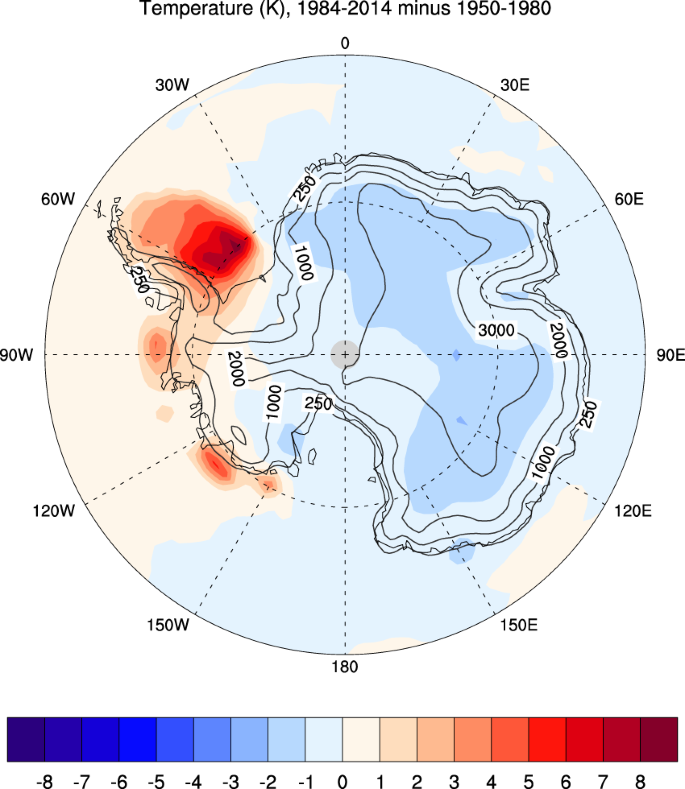A recent article from Frontline News, written by Chris Morrison originally for The Daily Sceptic, describes the difficulties climate alarmists are having explaining why Antarctica is not warming as quickly—if at all—as climate models suggest it should. There is a substantial amount of evidence that Antarctica is not warming as predicted or otherwise responding as climate models have projected during the period of recent climate change. There is also vigorous debate concerning why Antarctica is experiencing relatively little melting.
The article, “Scientists struggle to understand why Antarctica hasn’t warmed in over 70 years despite rise in CO2,” goes into great detail about the large amount of evidence showing how temperature and ice trends in Antarctica refute claims that the continent is on a path of catastrophic warming and ice loss.
“The lack of warming over a significant portion of the Earth undermines the unproven hypothesis that the carbon dioxide humans add to the atmosphere is the main determinant of global climate,” explains Chris Morrison.
Morrison points out that a 2020 study of Antarctica climate data found that the continent has actually seen a modest expansion of sea ice over the past seven decades, as well as net-zero warming across most of the continent. The only area displaying any warming at all is the Antarctic Peninsula region in the western part of the continent, however sea ice coverage in that region, Morrison explains, “is running at levels seen around 50 years ago.” Included in the article is the graphic below, from the Singh and Polvani study, which visually demonstrates the isolated warming trend of the Peninsula amid the cooling trend the rest of the continent is experiencing.

Why Antarctica is not behaving as climate models suggest it should is an open question. Some researchers have suggested that the sheer depth and thickness of the ice across Antarctica dampens the continent’s sensitivity to atmospheric CO2 additions and the general warming trend. An explanation for the anomalous heating of the West Antarctic ice sheet and peninsula is discussed in the Climate Realism post, “Antarctic ‘Doomsday Glacier’ Is Really Doomsday for Climate Alarmism.” The rise in temperatures there may be due an increase in volcanic activity beneath the western ice sheet warming local waters.
As discussed in this Climate Realism post, here, multiple studies show that much of the continent has experienced cooling over the last few decades, with the exception of three temperature stations on the Antarctic Peninsula.
Despite data showing the contrary, mainstream media alarmists largely persist in pushing a climate-alarm narrative, hyping any ice calving that occurs along the vast coastline of the continent, without mentioning the full context of the ice loss.
In Climate at a Glance: Antarctic Ice Melt, the cumulative ice loss often publicized most widely is compared to the total ice mass of Antarctica. When the data is combined, total ice loss per year comes out to only 0.0003 percent of the total ice mass.
“Attempting to connect every natural variation in weather and long-term climate to just one trace gas produced by humans leads to some unconvincing explanations, not least when climate models are involved,” concludes Morrison, discussing how Antarctica’s behavior contradicts what climate model projections indicate should be occurring there. This is a lesson that could be applied elsewhere in discussions of climate change, as well.
The Earth’s climate is complex and nuanced, which is something that much of mainstream journalism fails to represent. It is always noteworthy when outlets like Frontline News acknowledge and discuss the fact that there is much uncertainty, indeed much unknown, concerning the how, why, and potential impacts of ongoing climate change. There is, or at least still should, be a lively debate concerning the causes and consequences of global warming in the press.


















I’m happy to say that Linnea Lueken has reached the same level of excellence as H. Sterling Burnett, who used to write these articles. Both authors are gold star authors in the opinion of this blog editor. Everything they write can be trusted and recommended. That makes it easier for me to find and list the 12 to 24 best climate science and energy articles I read every morning. A comparison with H. Sterling Burnett is a BIG complement from me. Keep up the good work.
https://honestclimatescience.blogspot.com/
In the article it is noted that the question has been asked: “Why Antarctica is not behaving as climate models suggest it should is an open question.”
Can I share my 2014 article: Computer Models: The Great Deception
Where I take apart my own investment model. http://heinzegroup.com/insight.htm#7
Compliment, not complement….
April 5, 2023 The Climate (CO2) Hoax and the Control Matrix. Mega-banks and Corporations
Part I
In my previous article ‘1500 scientists say ‘Climate Change Not Due to Co2’ – The real environment movement was hijacked’ I provided evidences and testimonies from renowned international climate scientists that contradict the UN assertions in relation to climate change being caused by Co2 emissions.